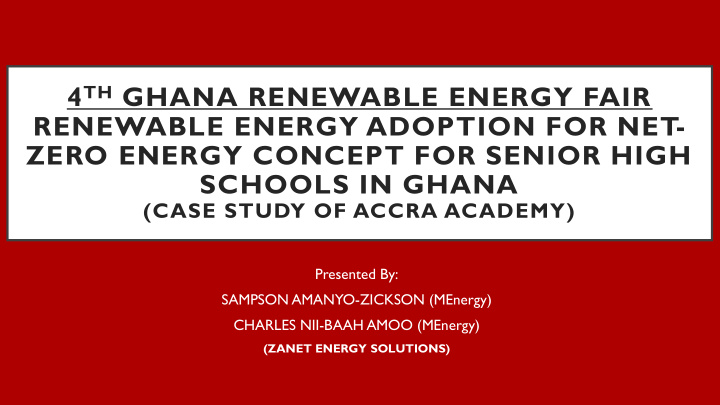



4 TH GHANA RENEWABLE ENERGY FAIR RENEWABLE ENERGY ADOPTION FOR NET- ZERO ENERGY CONCEPT FOR SENIOR HIGH SCHOOLS IN GHANA (CASE STUDY OF ACCRA ACADEMY) Presented By: SAMPSON AMANYO-ZICKSON (MEnergy) CHARLES NII-BAAH AMOO (MEnergy) (ZANET ENERGY SOLUTIONS)
AIM OF PROJECT Energy use is paramount to the operations of senior high schools (SHSs) in Ghana and poses a significant cost to their annual budgets. This project sought to assess the economic feasibility of a switch in energy consumption of SHSs in Ghana from traditional grid electricity and LPG to solar power and biogas. It is also to assess the probability of converting existing public senior high schools to NZE status.
NET -ZERO ENERGY BUILDING (NZEB) CONCEPT NZEB, the concept which stipulates that buildings (or sites) produce as much energy as they use over the course of a year has been evolving from research to reality. Currently, there are only a small number of highly efficient buildings that meet NZEB status. Energy Efficiency Efficient Active Appliances Solar NZEB Efficient Biogas Lighting Passive Solar
DATA OF ACCRA ACADEMY “Boys - only” SHS in Accra with a student and staff population of 2300 Total electricity consumption of 68.8 MWh in 2017 – about 9% and 20% more than what was consumed in 2016 and 2015 respectively. The total cost of electricity in 2017 was US$ 29,650 approximately 6% and 18% more than the cost in 2016 and 2015 respectively. The quantity of LPG used in 2017 was 21.2 tonnes at a cost of US$22,371.
METHODOLOGY Energy Audit was to identify when, how, where, and why energy is used in Accra Academy and recommend ways to ensure energy efficiency. Renewable energy deployment assessment was to calculate the financial benefits of a switch in energy type from conventional to clean energy. Alternative Energy Choices Grid Electricity Solar Power LPG Biogas
ENERGY CONSUMPTION DISTRIBUTION OF ACCRA ACADEMY BY DEPARTMENTS Administration Classrooms Administration Bungalows 19% 23% Kitchen Halls Classrooms Bungalows 12% Halls 24% Kitchen 22%
ENERGY CONSUMPTION DISTRIBUTION PER INDUCTIVE vs RESISTIVE LOAD APPLIANCES PROPORTION IN ACCRA ACADEMY Others Computer 1% Mill & Motors 11% 10% Air conditioners 9% Fan 23% Inductive Resistive Load Load 40% Resistive Load Inductive Load 60% Refrigeration Iron 25% 9% Audio player 1% Television Light bulb 2% 9%
SOLAR ENERGY ASSESSMENT QUANTITY/COST OF GRID ELECTRICITY CONSUMPTION 250 100.00 QUANTITY OF ELECTRICITY CONSUMED, MWh Thousands 92.03 90.00 86.82 81.90 200 80.00 COST OF ELECTRICITY, GHS 77.27 72.89 70.00 68.77 63.11 150 60.00 57.50 50.00 100 40.00 30.00 50 20.00 10.00 0 0.00 2015 2016 2017 2018 2019 2020 2021 2022 (Projected) (Projected) (Projected) (Projected) (Projected) YEAR
SOLAR vs GRID SOLAR ENERGY PRODUCTION vs GRID ENERGY CONSUMPTION COMPARISON Grid Power Usage Projection Solar Power Projection 120 CONSUMPTION/PRODUCTION, MWH 100 ANNUAL ENERGY 80 60 40 20 0 2018 2019 2020 2021 2022 2023 2024 2025 2026 2027 2028 2029 2030 2031 2032 2033 2034 2035 2036 2037 YEAR
BIOGAS SYSTEM ANALYSIS ― 51% LPG REPLACEMENT LPG CONSUMPTION PROJECTION FOR 5 YEARS Quantity of LPG used Cost of LPG used 24000 40,000 35,000 23000 QUANTITY OF LPG, KG 30,000 COST OF LPG, $ 22000 25,000 21000 20,000 15,000 20000 10,000 19000 5,000 18000 - 2016 2017 2018 2019 2020 2021 2022 YEAR
PROJECT SUMMARY System IRR Percentage Payback, yr Replacement Solar with 15% 100% 8 batteries Biogas 22% 51% 4.2 CO 2 ABATED 873 tCO 2 – e emission abatement over 25 years
Energy Efficiency (EE) Active Passive Measures Measures What is EE? Refrigeration Skylight Why going purely solar is not enough? Areas with greatest opportunity for energy saving Fan Awning Encourage Milling louvre motors The way forward NZEB in Ghana windows Discourage Extensive aluminium Assessing the cost existing building retrofit versus new NZEB metering roofing Energy Policies Switches Window film The role of MWH and public buildings
Recommend
More recommend